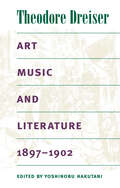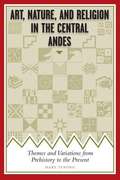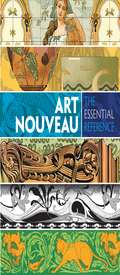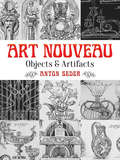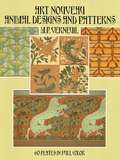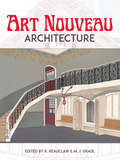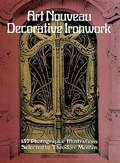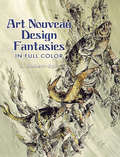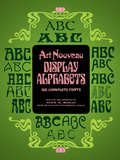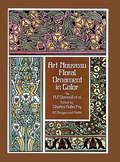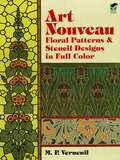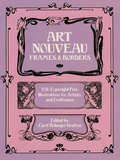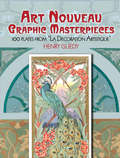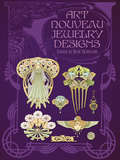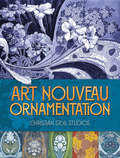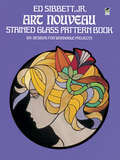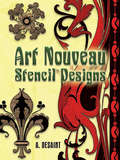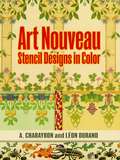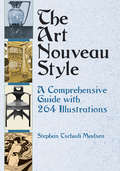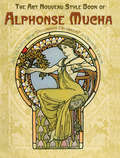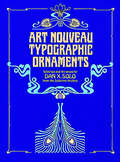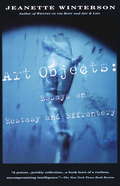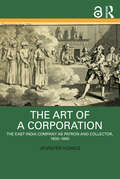- Table View
- List View
Art, Music, and Literature, 1897-1902
by Theodore DreiserDreiser's captivating portraits of turn-of-the-century America's famous figures In this volume, liberally seasoned with period illustrations, Yoshinobu Hakutani has collected and annotated a rich selection of Theodore Dreiser's pre-fame writings on the cultural milieu of his day. In these brief essays, Dreiser sallies into the vibrant world of creative work in turn-of-the-century America. He inspects the eccentric and revealing paraphernalia of artists' studios, probes the work habits of writers, and goes behind the scenes in the popular song-writing business, where this week's celebrity is next week's has-been. He profiles famous figures and introduces numerous women artists, novelists, and musicians, including the prolific and tireless Amelia Barr (mother of fourteen children and author of thirty-two novels), the illustrator Alice B. Stephens, and the opera singer Lillian Nordica. Hakutani's notes provide biographical detail on dozens of now-obscure individuals mentioned by Dreiser.
Art, Music, and Mysticism at the Fin de Siècle: Seeing and Hearing the Beyond (Routledge Research in Art History)
by Michelle Foot Corrinne ChongThis edited volume explores the dialogue between art and music with that of mystical currents at the turn of the twentieth century. The volume draws on the most current research from both art historians and musicologists to present an interdisciplinary approach to the study of mysticism’s historical importance. The chapters in this edited volume gauge the scope of different interpretations of mysticism and illuminate how an exchange between the sister arts unveil an underlying stream of metaphysical, supernatural, and spiritual ideas over the course of the century. Case studies include Charles Tournemire, Joseph Péladan, Erik Satie, Hilma af Klint, Jean Sibelius, František Kupka, and Wassily Kandinsky. The contributors’ unique theoretical perspectives and disciplinary methodologies offer expert insight on both the rewards and inevitable aesthetic complications that arise when one artform meets another. The book will be of interest to scholars working in art history, musicology, visual culture, and mysticism.
Art, Nature, and Religion in the Central Andes: Themes and Variations from Prehistory to Present
by Mary StrongFrom prehistory to the present, the Indigenous peoples of the Andes have used a visual symbol system—that is, art—to express their sense of the sacred and its immanence in the natural world. Many visual motifs that originated prior to the Incas still appear in Andean art today, despite the onslaught of cultural disruption that native Andeans have endured over several centuries. Indeed, art has always been a unifying power through which Andeans maintain their spirituality, pride, and culture while resisting the oppression of the dominant society. In this book, Mary Strong takes a significantly new approach to Andean art that links prehistoric to contemporary forms through an ethnographic understanding of Indigenous Andean culture. In the first part of the book, she provides a broad historical survey of Andean art that explores how Andean religious concepts have been expressed in art and how artists have responded to cultural encounters and impositions, ranging from invasion and conquest to international labor migration and the internet. In the second part, Strong looks at eight contemporary art types—the scissors dance (danza de tijeras), home altars (retablos), carved gourds (mates), ceramics (ceramica), painted boards (tablas), weavings (textiles), tinware (hojalateria), and Huamanga stone carvings (piedra de Huamanga). She includes prehistoric and historic information about each art form, its religious meaning, the natural environment and sociopolitical processes that help to shape its expression, and how it is constructed or performed by today’s artists, many of whom are quoted in the book.
Art Not by Eye: The Previously Sighted Visually Impaired Adult in Fine Arts Programs
by Yasha LisencoThe book, in two parts, deal with avenues for adventitiously blind adult, and the blind and severely visually impaired adults in the art program.
Art Nouveau: The Essential Reference (Dover Pictura Electronic Clip Art Ser.)
by Carol Belanger Grafton"This is a gorgeous book, ideal for any lover of Art Nouveau." --bookaddictionDover's extensive library of Art Nouveau graphic art and typography serves as the source for this comprehensive volume, which features hundreds of magnificent full-color and black-and-white illustrations. Images by virtually every key artist of the Art Nouveau movement include the work of Alphonse Mucha, E. A. Seguy, Aubrey Beardsley, Koloman Moser, Max Benirschke, and M. P. Verneuil. Selections from rare books and portfolios of the period include works never reprinted since their initial publication. This book also reprints material from the major Art Nouveau periodicals, including Jugend, The Studio, Dekorative Vorbilder, and The Keramic Studio. Detailed bibliographical information concerning every source - including biographical details of each artist - makes this collection a vital reference tool as well as a stunning compendium of significant and beautiful Art Nouveau graphics. Students of graphic art, typography, and illustration, as well as graphic designers and advertising professionals, will prize this remarkable resource.
Art Nouveau: Objects and Artifacts (Dover Pictorial Archive)
by Anton SederA revolutionary reaction to the eclectic historical styles of nineteenth-century art, the turn-of-the-century Art Nouveau movement drew much of its inspiration from nature. Applying its sinuous, curvilinear motifs to the decorative arts, graphics, architecture, sculpture, and painting, artists and crafters attempted to create a style suitable for a "modern" age. This treasury of rare Art Nouveau decorative ornaments offers an unusual selection of the genre's most strikingly imaginative graphics. Originally published in Paris in 1899 and sold by subscription, the collection features fifty full-page plates depicting a rich profusion of everyday items rendered in the distinctive Art Nouveau style. Intricate patterns of flowers, vines, faces, and other designs decorate scores of objects made of metal, ceramic, and glass: pitchers and vases, cutlery, walking sticks, jewelry, and other objects and artifacts. A source of authentic Art Nouveau graphics, this compilation will serve as an inspiration for artists, illustrators, and designers.
Art Nouveau Animal Designs and Patterns: 60 Plates in Full Color (Dover Pictorial Archive)
by M. P. VerneuilThis design collection includes all 60 full-color plates from L'animal dans la décoration, a rare turn-of-the-century portfolio by M. P. Verneuil. Meticulously reproduced from the originals, these plates offer a splendid demonstration of the application of animal forms to decorative art. Included are not only representations of such traditional decorative motifs as deer, swans, and peacocks, but also depictions of creatures seldom associated with beauty and ornamentation: bats, mice, lizards, insets, and other less conventional subjects. M. P. Verneuil was one of the leading lights of the influential Art Nouveau movement. His extraordinary inventiveness and draftsmanship can be seen here in detailed tableaux of animals and plants often wittily represented as interlocking parts of a larger decorative design. Butterflies, dragonflies, and bats float amid schematized flora; sea horses, flying fish, and gulls cavort in and above stylized seas; and a host of other fauna is similarly rendered with breathtaking imagination and ingenuity. Graphic artists, illustrators, craftspeople -- any student of design -- will want to have this book as an invaluable copyright-free source of artistic inspiration and as an eye-opening excursion into the rich and sensuous realms of the finest Art Nouveau design.
Art Nouveau Architecture
by R. Beauclair M. J. GradlPublished in Paris in 1902, these rare plates offer a unique source of details of the era's "modern" architecture. The 58 full-color images originally appeared in a short-lived periodical from the height of the Art Nouveau period. They provide an authentic source of information on how Art Nouveau influenced architectural design in the early twentieth century. Illustrations include windows, doorways, joists, railings, stairways, chimneys, ornamental woodwork, exterior decoration, elaborate ironwork, and much more. Additional plates depict interior and exterior views of these architectural elements in actual and planned buildings and rooms designed by architects of the period. Brief captions supply details for each plate. This treasury of rare illustrations and information represents a valuable resource for students of art history and the history of architecture as well as for architects and designers interested in Art Nouveau.
Art Nouveau Decorative Ironwork
by Theodore MentenAround the turn of the twentieth century, artists and craftsmen throughout Europe and America were profoundly affected by a new art style that took its inspiration from nature. Generally referred to as Art Nouveau, it exerted its influence on painters, illustrators, architects, ironworkers, furniture designers, interior decorators, potters, jewelry designers -- in fact, nearly every kind of artist-craftsman. While Art Nouveau is a broad and varied style, it is almost uniformly characterized by abstract, asymmetrical, curvilinear design. The thrust of this "new art" was twofold: to elevate the status of the "crafts" to equals and partners of the "fine arts"; and to bring a designed object into a harmonious relationship with its environment through the use of lines -- either expressive or controlling -- that were natural, vital, and most importantly, organic.Among the most imaginative realizations of these pervasive rhythms and serpentine patterns was the ironwork that was created during this period and still exists in major European cities (chiefly Paris and Brussels). Gates, railings, balconies, doorways, staircases, elevator cages, grilles, lampposts, and many other architectural features reveal the sinuous forms, foliate motifs, expert craftsmanship, and rich detail characteristic of the style.No other existing work documents so extensively and accurately the full range of Art Nouveau ironwork. Derived from now unavailable sources, this new anthology attests to the enduring qualities of both the design and its constructive material. Graphic designers, illustrators, architects, artists, and craftspeople of all disciplines will discover numerous ornamental ideas, authentic motifs, and design solutions among the 137 royalty-free photographic illustrations. Collectors and enthusiasts unfamiliar with this particular area of Art Nouveau will delight in the exquisite craftsmanship, ornamental felicities, and juxtaposition of strength and beauty as they observe these unyielding iron creations fashioned into delicate germinating buds and wandering tendrils. Captions for the photographs provide the building, city, architect, and designer of the ironwork. These latter include such notables as Victor Horta, Paul Hankar, Louis Majorelle, Charles Plumet, and Emile Robert. Their work and that of many others is preserved in this fine selection of photographs.
Art Nouveau Design Fantasies in Full Color
by J. Habert-DysElegant and distinctive, these eye-catching motifs combine a refined naturalism with the sophistication of Art Nouveau. Created during the early years of Art Nouveau, they reflect the late nineteenth century interest in Japanese art, as well as the fresh excitement of a blossoming movement that's remained fashionable for well over a century.Sixty-six full-color images feature luxurious patterns and ornaments designed for ceramics, furniture, textiles, walls, and ceilings. Superbly reproduced from a rare folio, these decorations were formerly available only in high-priced antiquarian editions. This inexpensive compilation makes them readily accessible and royalty-free to graphic artists, crafters, and designers.
Art Nouveau Display Alphabets
by Dan X. Solo100 complete fonts from Solo-type Typographers Catalog: upper and lower cases, alternate forms, swash forms, numerals, secondaries. Whiplash, organic, cursive, Orientalized, other styles. Beautiful, wide range of type fluidities suggest elegance, originality, grace, nearness to nature. Most not elsewhere.
Art Nouveau Floral Ornament in Color (Dover Pictorial Archive)
by Francis A. Davis Maurice P. VerneuilClassic portfolio includes 197 original designs, shown on 48 color plates: arrowhead, blackberry, buttercup, columbine, gourd, honeysuckle, iris, thistle, more; plus animal motifs: seahorses, kingfishers, peacocks, others, as well as some rarely associated with ornamental beauty such as rats and lizards. "An attractive and useful reference source." -- Theatre Craft.
Art Nouveau Floral Patterns and Stencil Designs in Full Color (Dover Pictorial Archive)
by M. P. VerneuilMagnificent collection of floral patterns and stencil designs, created by one of the movement's finest artists, includes 120 images of graceful garden flowers --foxglove, hollyhocks, columbine, lilies, among others, and 39 stencil designs of blossoming trees, reeds, mushrooms, oak leaves, peacocks, and more.
Art Nouveau Frames and Borders: 250 Copyright-free Illustrations For Artists And Craftsmen (Dover Pictorial Archive)
by Carol Belanger GraftonIndispensable collection for enhancing menus, invitations, ad copy, greeting cards, catalogs -- almost any graphic project -- includes 199 black-and-white designs, among them crisply rendered floral and foliate motifs, butterflies and peacocks, female figures and sensuous cherubs, asymmetrical shapes and undulating lines, all in a variety of shapes and sizes.
Art Nouveau Graphic Masterpieces: 100 Plates From "La Decoration Artistique" (Calla Editions)
by Henry GuedyPublished in Paris before World War I, these decorative Art Nouveau graphics originally appeared in a now-rare periodical, La Decoration Artistique. This compilation presents 100 full-color plates in a beautiful assortment of period designs that will prove essential to collectors of the era's best and hardest-to-find illustrations. A splendid variety of images includes headpieces, typographical banners, and other designs rendered in the distinctive Art Nouveau style, all embellished with naturalistic motifs, from parrots and peacocks to sinuous vines and flowers in full bloom. Other illustrations feature storefront signage for bakeries and cafés; decorative friezes of theatrical masks and grapevines; borders of blossoms, books, and birds; stenciled decorations for fire screens; and corner and ceiling ornaments. Art aficionados, designers, artists, art students, and anyone with a taste for Art Nouveau will delight in this extraordinary collection, which offers a lasting source of inspiration and pleasure.
Art Nouveau Jewelry Designs
by Rene BeauclairAt the turn of the twentieth century, the Art Nouveau movement swept the world of decorative arts toward an excitingly modern direction. Inspired by both organic and geometric forms, the new trend abandoned historical styles in favor of flowing, natural forms accented by angular contours. Art Nouveau's curves and floral and animal motifs were particularly suited to adaptations in precious stones and rare metals. The elegant, royalty-free illustrations of this collection, reprinted in their original colors from a rare German edition, offer authentic representations of the craftsmanship and imaginative qualities involved in the creation of Art Nouveau jewelry.This sumptuous assortment presents more than 300 pendants, combs, rings, bracelets, brooches, buttons, clasps, and earrings. The exquisitely detailed jewelry and accessories feature lilies, morning glories, and other floral motifs as well as butterflies, seahorses, birds, and a host of fanciful creatures. René Beauclair, a renowned Art Nouveau designer, includes his own works as well as those of André Petitjean, Jules Armbruster, Paul Liénard, Emile Jammes, and Paul F. Follot. The striking, royalty-free illustrations are readily adaptable to any design use and will serve as a source of inspiration for jewelry designers and crafters of all kinds.
Art Nouveau Ornamentation
by Christian StollThis splendid source of authentic Art Nouveau designs presents more than 90 breathtaking plates, ranging from single to full color, selected from rare originals of a renowned German studio's stock portfolios.
Art Nouveau Stained Glass Pattern Book
by Ed Sibbett Jr.Stained glass workers will welcome this book containing 104 authentic Art Nouveau patterns newly rendered by Ed Sibbett, Jr.In the typical Art Nouveau style are 104 designs in this book: florals with stem and leaf patterns; sensuous women with billowing hair, dresses, and exquisite headpieces; fish; butterflies; peacocks; Beardsley-like women in profile wearing masks; and many, many others. Some of these designs are intermediate to advanced and will be a challenge to skilled craftsmen, while others are simple enough for beginners in the field. They can be used whole or in part for windows, panels, lampshades, mirrors, frames, mobiles, or other craft projects.
Art Nouveau Stencil Designs (Dover Pictorial Archive)
by A. DesaintThis unusual collection of stencil designs showcases the sinuous elegance of Art Nouveau, with 44 plates dating from the 1920s. Inspired by interior and exterior architectural ornaments of buildings in France and Britain, the designs are meticulously reproduced from a rare vintage publication.Attractive patterns range from decorations for churches, drawing rooms, nurseries, and everything in between, including halls, galleries, and corners. The elaborate borders, friezes, and festoons include exquisite images of children, animals, birds, rosettes, and heraldic designs. These finely detailed, royalty-free patterns are an invaluable resource, perfect for adding a distinctive note to fabrics, stained glass, wallpaper, and a host of other art and craft projects. Browsers and devotees of the Art Nouveau style will also appreciate this treasury of striking stencil designs.
Art Nouveau Stencil Designs in Color (Dover Pictorial Archive)
by A. Charayron Leon DurandDrawn from a rare French volume, this gallery of delicate multicolor stenciling in the Art Nouveau style features the use of pochoir, a unique method that was popular in Paris during the early part of the twentieth century. Distinctive for its clear, sharp lines, vibrant colors, and textured surfaces, pochoir stenciling was used in fashion journals, interiors, architecture, and industrial design--and offers a host of applications in those areas today. Steeped in the flowing, graceful style of Art Nouveau, this remarkable array of colorful illustrations showcases panels, friezes, walls, and ceilings, embellished with such natural delights as wild roses and nasturtiums, pears and grapes, seagulls and geese, rabbits and roosters, and children playing in country settings. The high-quality, royalty-free art will prove to be an abundant source of inspiration for crafters, decorators, and graphic designers.
The Art Nouveau Style: A Comprehensive Guide with 264 Illustrations
by Stephan Tschudi MadsenA revolutionary reaction to traditional nineteenth-century art, the turn-of-the-century Art Nouveau movement drew much of its inspiration from nature. Applying its sinuous, curvilinear motifs to the decorative arts, graphics, architecture, sculpture, and painting, artists and craftspeople attempted to create a style suitable for a "modern" age. In this absorbing, exceptionally detailed, and well-researched book (one of the first scholarly works to revive interest in the style after World War II), a noted Norwegian authority on the subject examines the movement in depth. Stephan Madsen offers a wealth of facts and insights about the origins and development of the style; trends leading up to Art Nouveau, including the influence of Blake and the Pre-Raphaelites; early Art Nouveau posters and book illustrations; and its use in architectural ornamentation, furniture, jewelry, wrought-iron, glass, and other applied arts. A magnificent selection of 264 photographs and line drawings accompanies the text, which gives broad coverage to the movement, as well as insightful discussions of such important artists as Emile Gallé, Alphonse Mucha, Walter Crane, Charles Rennie Mackintosh, Aubrey Beardsley, Henry Van de Velde, Victor Horta, William Morris, and Eugène Grasset.Artists and students, admirers of Art Nouveau, and anyone interested in this enduring and influential style will welcome Professor Madsen's expert, fully documented study.
The Art Nouveau Style Book of Alphonse Mucha
by Alphonse MuchaTo the general public, Alphonse Maria Mucha (1860-1939) is perhaps best known for his posters of Sarah Bernhardt and magnificent decorative panels such as "The Seasons" -- works that continue to grow in popularity and value as the resurgence of interest in Art Nouveau increases. Among graphic artists and commercial designers, Mucha is praised for the innovative style books that pioneered the use of Art Nouveau in commercial packaging, design, and ornament.The most important of these style books was Documents Décoratifs, published in 1901 at the height of Mucha's fame as the high priest of the Art Nouveau movement. While the artist's fame rests largely on his posters, it is in the smaller works of the style books, or design portfolios, that the refinement of his technique can best be appreciated. The present volume, carefully reproduced from an extremely rare and valuable set of originals, contains all 72 plates of the Documents Décoratifs portfolio. Included are designs for jewelry, wallpaper, stained glass, furniture, and tableware; figure and botanical studies; and a selection of Mucha's famous panneaux décoratifs. Eighteen of the plates are in full color, while the remaining 54 are reproduced in two or more color tones.In addition to numerous innovative designs for practical and decorative objects, the elegant draftsmanship and meticulous execution that characterized all of Mucha's work is evident in studies of langorous nudes, portrait sketches, delicately rendered plant and animal motifs, exquisite modeling of drapery and cloth, and the flowing, fantastic forms created as experiments in pure design. In the Foreword by Gabriel Mourey, specially translated for this edition, Mucha's own philosophy of art, and the relation of the Documents to the rest of his work, receive an appreciative and informative discussion.Hitherto available only in scattered sources, or in the libraries of wealthy collectors, the complete Documents Décoratifs is now available in this inexpensive one-volume edition. Lovers of Mucha's work, admirers of Art Nouveau, and the application of that style to the decorative arts, will want to own this fine royalty-free collection by one of the greatest masters of the technique."[Documents Décoratifs is] . . . an encyclopedic source for Mucha's style in every branch of decorative and applied art and one of the few books on design where even individual plates are sought after by collectors." -- Marina Henderson, The Graphic Style of Alphonse Mucha
Art Nouveau Typographic Ornaments (Dover Pictorial Archive)
by Dan X. SoloOver 800 Art-Nouveau florals, swirls, women, animals, borders, scrolls, wreaths, spots and dingbats, copyright-free.
Art Objects: Essays on Ecstasy and Effrontery
by Jeanette WintersonIn these ten intertwined essays, one of our most provocative young novelists proves that she is just as stylish and outrageous an art critic. For when Jeanette Winterson looks at works as diverse as the Mona Lisa and Virginia Woolf's The Waves, she frees them from layers of preconception and restores their power to exalt and unnerve, shock and transform us."Art Objects is a book to be admired for its effort to speak exorbitantly, urgently and sometimes beautifully about art and about our individual and collective need for serious art."--Los Angeles Times
The Art of a Corporation: The East India Company as Patron and Collector, 1600-1860
by Jennifer HowesThe Art of a Corporation is a comprehensive study of artworks that were commissioned and collected by the East India Company from the early seventeenth to the midnineteenth centuries. These items range from oil paintings on canvas and marble statuary, to sandstone Buddhas and metal figurines of Hindu deities. The book takes a chronological approach and focuses on provenance to show that objects are valuable primary resources for understanding the East India Company’s history. The artworks illustrate how one of the longest-surviving multinational corporations in the Western world changed over its three-century history and provide a powerful visual account of its perpetually reinvented image. This book is a must read for scholars and researchers of art history, colonial art, colonial studies, British history, economic history, business history, South Asian history, post-colonial studies, and cultural studies. Chapter 1 of this book is freely available as a downloadable Open Access PDF at http://www.taylorfrancis.com under a Creative Commons Attribution-NonCommercial-NoDerivatives 4.0 International license.
